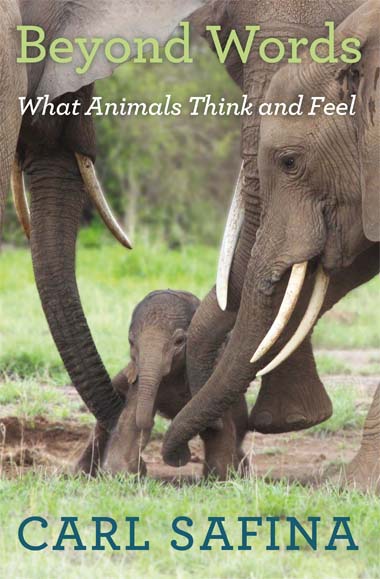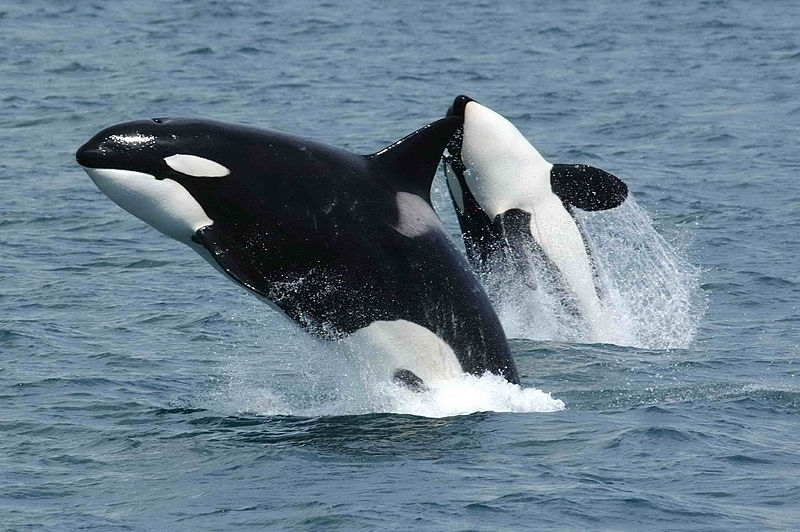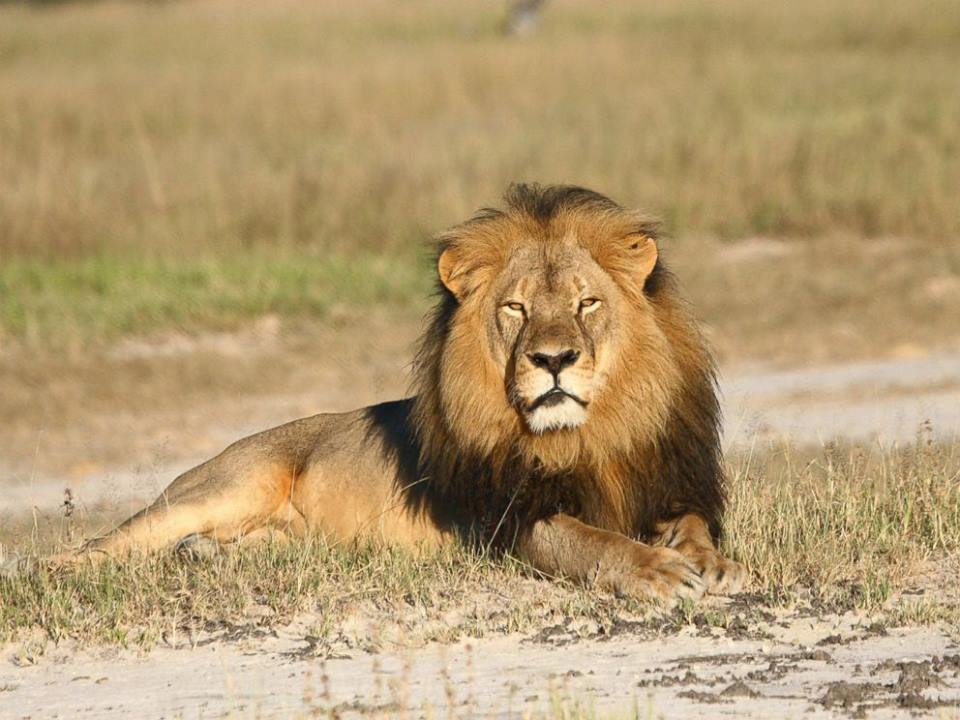Carl Safina has created a literary career writing books about the ocean, whether tracing the life of an albatross named Ameila, chasing after sea turtles in the Pacific, or following the seasons at his beachside home on Long Island.
But his newest book, Beyond Words: What Animals Think and Feel, takes a sharp turn away from his past work. Not only does Safina spend three fourths of the book on land with elephants, wolves and dogs, but instead of documenting external conservation issues, he focuses on the inner lives of his animal subjects.

Employing the newest science, personal observation and unapologetic reason, Safina abolishes the centuries-long view that animals are somehow unthinking automatons. Instead, he paints a picture of a wild world populated by emotional, cognitive, social and political beings—incredibly similar to our own inner lives, and yet…very different.
“I wanted to make the case for conservation in a new way,” said Safina in an interview with Mongabay (read in full below). “We hear status reports about ‘nature’ in statistics like: 60 percent of the habitat gone, 15 percent of a population remaining, 3,000 endangered individuals left… Anyone can read about how much we are losing. I wanted to show who these creatures are. I want us to feel, beneath our ribs, why they must live.”

In the book’s four sections, Safina employs his clear-headed, conversational, but often beguilingly beautiful prose to illuminate the lives of elephants, canines (both wild and domestic) and killer whales. In the process, we begin like Safina to view these animals not as cogs in an ecosystem’s wheel or as commodities for our use, but as individuals with distinct personalities and vital roles in their community.
“We have no trouble saying that an animal who’s vigorously eating is hungry, and one resting after exertion is tired; yet we can hardly force ourselves to acknowledge that when they’re playing they’re having fun, or that when they’re acting affectionate they’re feeling the bond,” Safina said. “Why? Because denying them all experience reinforces our favorite story: that we are so very special.”
But, refreshingly, Safina isn’t writing this book from a doe-eyed animal rights activist point of view, but from a PhD scientist’s perspective. He weaves the science of animal emotion, intelligence and personality throughout the book, and remains fearless in his skepticism. That said, his experiences with these unique creatures, and the stories he hears, changes him.
“Before I encountered these stories, I was dismissive,” he writes in Beyond Words. “Now I feel shaken out of certainty. I’ve suspended disbelief. It’s an unexpected feeling for me. The stories have forced open doors I had shut, doors to that greatest of all mental feats: the simple sense of wonder.”
In an August, 2015 interview, Safina discusses the childhood origins of his new book, whether or not some animals may be wiser than humans and gives his take on the outrage over the recent killing of Cecil the Lion.

AN INTERVIEW WITH CARL SAFINA
Mongabay: Your past books have largely focused on the oceans and conservation issues. What led you to turn your lens to the science and implications of animal intelligence and sentience?
Carl Safina: Several things. My main first interest since early childhood has always been, “What do animals do and why do they do it?” This book circles back to that early childhood interest. Also, I wanted to take a break from conservation—which turned out to be impossible because humans pervade the lives of the free-living elephants, wolves, and killer whales I worked with, and so many others. And conversely I wanted to make the case for conservation in a new way. We hear status reports about “nature” in statistics like: 60 percent of the habitat gone, 15 percent of a population remaining, 3,000 endangered individuals left. In that telling, the disappearance of the world clocks in as a mere series of numerals. Anyone can read about how much we are losing. I wanted to show who these creatures are. I want us to feel, beneath our ribs, why they must live. All the animals that human parents paint on nursery room walls, all the creatures depicted in paintings of Noah’s ark, are in mortal trouble now. Their flood is us. What I’ve tried to show is how other animals experience the lives they so energetically and so determinedly cling to.
Mongabay: You write about animals as distinct individuals. As you put it they are a “who” not an “it”. Should journalists and science writers start writing similarly, especially given the recent evidence about the importance of personality in so many animals?
Carl Safina: I shy from telling other people what they should do. I hope to make a case. If it’s a strong enough case that it inspires other people to shift their thinking and how they speak, I’ve accomplished part of my goal. But the desire to make the shift can only come from within others; I don’t want to impose it.

Mongabay: Why do you think we are so loving and indulgent towards domestic dogs, but so malevolent and fearful towards wolves?
Carl Safina: When we first became aware of dogs, we didn’t know who they were or where they came from. We met them on neutral terms for who they are. We persecute and fear wolves not because we know them, but because we don’t know them. Native hunter-gathering peoples had no problem with wolves, and their descendants still have no problem with them and seek to protect them, for instance by blocking hunting of wolves. It’s the same with people. When we meet them, we see who they are. When we bring the baggage and biases we’ve been taught, we fear or even hate them. It’s a problem of our own making, a product of our own ignorance.
Mongabay: Are elephants and killer whales wiser than us? Could they be better than us in a moral sense?
Carl Safina: It depends who you mean by “us.” Humans include by far the kindest, most compassionate, most creative, most violent, most destructive and cruelest animal in the history of the world. We are the only creature capable of creating global problems. Demonstrably, we are not capable of solving the biggest problems we’re creating. If wisdom means using experience to make beneficial decisions, then we have a serious wisdom deficit. I would not say elephants and killer whales are wiser than us, but they are far less troublesome and far more benign. They do not harm the world.

Mongabay: In all your research on animal intelligence and emotions, what discovery or story surprised you most?
Carl Safina: The most surprising thing is that there are still many people who are so confused by the evidence, who don’t know whether other animals are conscious, have experiences, realize they are individuals, and have emotions. At the extreme least, it should be obvious that many other animals are capable of feeling fear or comfort. We have no trouble saying that an animal who’s vigorously eating is hungry, and one resting after exertion is tired; yet we can hardly force ourselves to acknowledge that when they’re playing they’re having fun, or that when they’re acting affectionate they’re feeling the bond. Why? Because denying them all experience reinforces our favorite story: that we are so very special; that the world owes us for being so special. That we are so special that we need never consider what we do to them or how much misery we cause. After all, they can’t be miserable because they don’t feel anything—right? We’re in denial because it’s convenient. And when it’s convenient, we say exactly these kinds of things about other groups of people we want to abuse or disregard.
Mongabay: What do you say to scientists who are still skeptical over animal intelligence and rights?
Carl Safina: Not much. That’s why I write. One issue with science is lack of standard definitions, leading to lots of confusion. People argue partly because they use the same words to mean different things. In my book I carefully define what I mean by words like consciousness, empathy, grief, intelligence, self-awareness, and so on. Only then can we have an actual discussion. And what we see is that because life has evolved, all these things are on a continuum, and some other species have all these capacities to varying extent. Self-loathing and cruelty—the desire to cause suffering—seem uniquely human.
By the way, I am not fully on board with animal rights and animal personhood movements. I think their understanding of other species is somewhat simplistic, yet their arguments are unnecessarily complicated. What other animals need is kindness, humane treatment, and room to live. It’s not too complicated.
Mongabay: What kinds of future research would you like to see when it comes to animal behavior and intelligence? What areas are we still neglecting?
Carl Safina: The main thing we’re neglecting is that the claim of other species to existence is on par with our own. They have vivid lives, they try hard to stay alive and keep their babies alive, and we need to leave them the room they need to be who they are. The part we’re neglecting is that 10 billion of us is not twice as good as 5 billion. By any definition we are an invasive species, now at plague proportion. Because there are too many of us, extinction rates are sharply up. We are creating an extinction spasm unprecedented in tens of millions of years. We don’t need more research to realize these things. We just need to get real.

Mongabay: What’s your view of the recent social media outrage over Cecil the Lion and trophy hunting in general? Is this evidence that our relationships to animals is continuing to shift?
Carl Safina: Lions have declined 75 percent in number in my lifetime and their range has shrunken enormously. Because Cecil had a name, we recognized in him an identity. But all lions have identities to other lions, as people do to people. The outrage over Cecil shows both that our relationship to other animals is both improving and that we still mainly don’t recognize the most basic things about them.
Mongabay: Where do you find hope in the world of wildlife and nature?
Carl Safina: When I was a kid there were essentially zero ospreys, peregrine falcons, and bald eagles left in most of the United States. There was a great awakening—what became known as the environmental movement—and we did what was necessary to let those species recover. In U.S. waters now, many fish species are recovering because of improving (and hard-fought) awareness and policies. I find hope in the beauty and resilience of other species and the fact that conservation works when people choose it.
